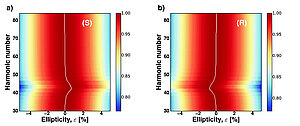Two enantiomers of a chiral molecule are just like our left and right hands: they are mirror images of each other. They have identical physical properties, except when interacting with chiral light. In linear chiroptical spectroscopy, the chiral response, often referred to as "chiral dichroism," is very low, in the range of 10-4 - 10-5 of a normal linear optical response, such as light absorption. This poses a major challenge to time-resolved measurements. This challenge was addressed in the paper by Cireasa et al. in which a new approach to chiroptical recognition is demonstrated and analyzed.
The new approach is based on high-harmonic spectroscopy. High-harmonic generation occurs when an intense femtosecond laser pulse is focused into a gas. It can be understood as a sequence of three steps: ionization in a strong infrared field, laser-induced acceleration of the released electron, and its recombination with the parent ion, all within one laser cycle. The recombination results in the emission of coherent radiation which extends from the vacuum ultraviolet to the soft X-ray region.
